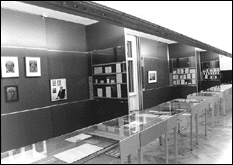16 March 1998 – March 1999
In a multimedia exposition of the Schönberg Legacy the Arnold Schönberg Center opened its doors in Palais Fanto, an exposition that reviewed the cosmos of the composer, painter, poet, thinker, inventor and teacher through representative examples taken from Schönberg’s personal belongings.
The first curator of this artistic legacy was Schönberg himself: throughout his life an archivally gifted visionary collector and guardian of what is considered an unparalleled heritage in the musical history of the 20th century, whose spectrum, ranging from philosophical and political, music-aesthetical and satirical, literary and period-probing texts to diverse artistic creations – portraits and self-portraits, landscapes, caricatures, drafts of stage sets, playing cards – and finally to the invention of objects to answer the needs of everyday life, illuminate a personality who as both man and artist resisted to the end the tendency to conform, a personality worth discovering not just because of the indelible signature he left upon the music of his century.
On display together with oil paintings, gouaches and drawings, original music and text manuscripts – for instance, of “Moses und Aron” or of questions concerning Judaism, of “Pelleas und Melisande” or of the “Method of Composing with Twelve Tones Relating Only to Each Other” – are inventions and notes of the composer, who had no wish to subjugate himself to the constraints of a system and who granted his art every freedom, who created “not out of ability, but out of necessity.” Private film clips, computer-stations, the latter enabling one to explore a correspondence database and an extensive discography, and audio stations where one can hear the complete works of Schönberg and recordings of his own voice, complete the presentation of what is considered to be the most famous legacy by a twentieth-century Austrian composer.

